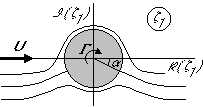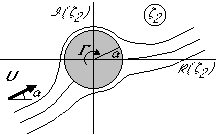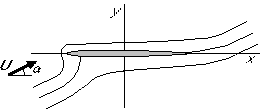(Book 18.10)
Conformal transformations are a way to generate more complex flow
fields from simple ones. They are based on distorting the
independent variable: Suppose we are given a complex
velocity potential F(z) depending on the complex coordinate z.
Now let ![]() be another complex coordinate, then
be another complex coordinate, then ![]() is also a
complex velocity potential, provided only that
is also a
complex velocity potential, provided only that ![]() is a
differentiable function of z.
is a
differentiable function of z.
Reason: according to the chain rule, the derivative of ![]() exists
and is equal to:
exists
and is equal to:
![]()
As an example of a conformal transformation, we will find the complex
potential around a flat plate airfoil, an airfoil of vanishing
thickness. We start with a flow field in a ![]() plane that is simply a
cylinder of unit radius with (clockwise) circulation
plane that is simply a
cylinder of unit radius with (clockwise) circulation ![]() in a
uniform stream U:
in a
uniform stream U:

![]()
According to the Kutta condition, the rear stagnation point must be located at what will become the trailing edge of the airfoil. If the stagnation point is anywhere else, the flow must bend around the trailing edge:


We can rotate the independent coordinate counter-clockwise like this by multiplying with a complex exponential:
![]()
The potential is in terms of ![]() :
:

Finally, we ``squeeze the airfoil flat in the vertical direction'' to a plate:


Exercise:
Show that the unit circle in the-plane, corresponds to a flat plate on the x-axis in the z-plane.
Note that the rear stagnation point ![]() becomes z=2, while
becomes z=2, while
![]() becomes z=-2. As a result, the chord of the
created airfoil is c=4.
becomes z=-2. As a result, the chord of the
created airfoil is c=4.
Since for large distances, ![]() , the potential at
large distances is
, the potential at
large distances is
![]()
The lift generated by the airfoil, ![]() will be normal to
the free stream U. This lift will depend on the angle of attack:
the lift is zero by symmetry when
will be normal to
the free stream U. This lift will depend on the angle of attack:
the lift is zero by symmetry when ![]() .
.
We now want to derive the relationship between the angle of attack
![]() and the lift. Remember that in the
and the lift. Remember that in the ![]() -plane, the
angle
-plane, the
angle ![]() determines the location of the rear stagnation point:
determines the location of the rear stagnation point:

![]()
![]()
![]()
The lift of an airfoil is expressed in terms of a lift coefficient:

Exercise:
Find the velocity on top and bottom of the flat plate airfoil as a function of x.
Exercise:
Integrate this velocity to find the circulation around the airfoil. Is it equal to?
Exercise:
Integrate the pressure difference over the airfoil to find the net force on it.
Exercise:
Is the result of the previous exercise as you expected? If not, what do you think is the difficulty?
Exercise:
Integrate the pressure difference over the the airfoil to find the moment around the center. From it , show that the resultant force acts at the point one-quarter chord behind the leading edge.
You should now be able to do The exercises above, 18.10, 11